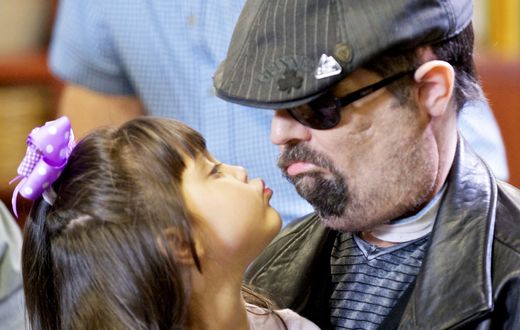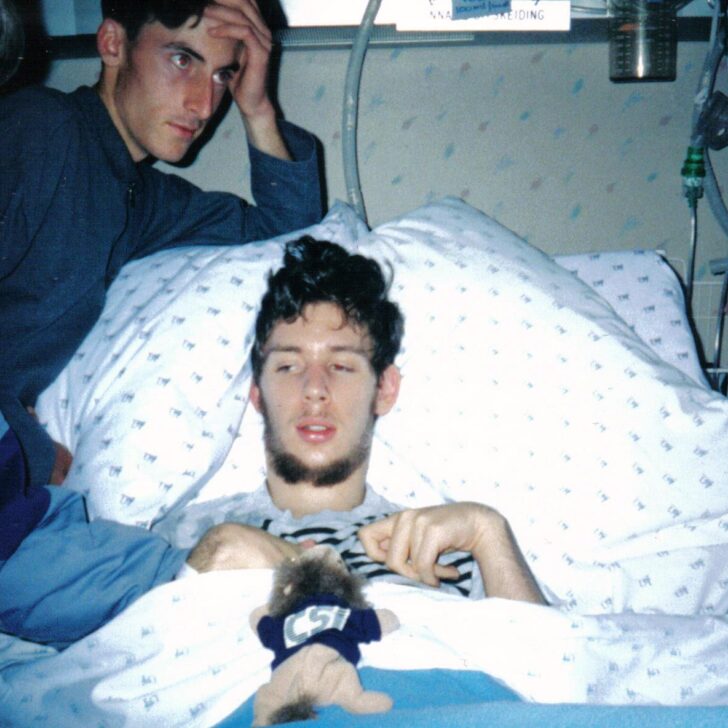Medical history is filled with groundbreaking procedures and daring experiments that have pushed the boundaries of human knowledge and saved countless lives.
From the first heart transplant in 1967 to the development of artificial organs, these moments have not only extended our life expectancy but also improved the lives of people suffering from debilitating injuries.


The advent of technologies like 3D printing, microsurgery, and tissue engineering has paved the way for procedures once considered impossible, offering renewed hope to individuals facing devastating injuries and disfigurements.
In 2008, a tragic accident would set the stage for another extraordinary medical feat.
Like something out of the movie Face Off, Dallas Wiens, a young man from Texas, became a pioneer and the first recipient of a full facial transplant.
The Incident And Injuries
The incident occurred on November 13, 2008, when Dallas Wiens was working on a painting job at Ridglea Baptist Church in Fort Worth, Texas.
Wiens was operating a boom lift as he was trying to paint a hard-to-reach area of the church. As he rose up the side of the building he failed to notice the electrical wires above him.
His forehead came into contact with the high-voltage wire, sending thousands of volts of electricity through his body.
Luckily, he survived, but his face was severely disfigured from the burns. He was rushed to Parkland Memorial Hospital, where doctors spent months working to save his life.
Wiens suffered fourth-degree burns to his face and skull, losing his eyesight, nose, lips, and most of the underlying facial structure.
Over a dozen surgeries were performed to remove the burned skin, and tragically, his left eye had to be removed. Surgeons also repositioned his right eye and covered it with a skin flap for protection.
In a grueling 36-hour procedure, they reconstructed his face using muscle from his back, leaving him with no facial features, just a horizontal opening where his mouth once was so he could breathe and eat.
Wiens was completely unrecognizable. He looked like a science experiment that went very wrong and his family feared that he would have to spend the rest of his life looking this way.
While recovering from his initial injuries, his medical team discussed the possibility of a full face transplant.
The procedure was new. Only a few partial face transplants had been done globally. But it offered Wiens hope of living a semi-normal life.
The Face Transplant Process
A full-face transplant is a surgical procedure where a person’s damaged or disfigured face is replaced with facial tissue from a deceased donor.
This operation involves transplanting skin, muscles, nerves, blood vessels, and sometimes even bones. A face transplant may seem like it’s just cosmetic but it also restores important functions such as eating, speaking, and breathing.

The first step for getting a full face transplant is finding a suitable donor. Unlike with organ donations which only require a blood type match, the appearance of the donated tissue is also important for living a normal life.
This means that the facial features and skin tone have to be as close to the original as possible.
To prepare for the surgery, Wiens had to undergo extensive medical evaluations, including psychological assessments and long talks with his surgical team to ensure that he understood the risks and potential complications going in.
These risks included infection, rejection of the transplanted tissue, and the need for lifelong immunosuppressive medications to prevent rejection.
Despite these risks, Wiens’ determination to regain a semblance of normalcy and his unwavering faith in the medical team led him to proceed with the surgery.
The Surgery And Recovery
On March 14, 2011, Dallas Wiens went under the knife in hopes of restoring his face. A team of over 30 medical professionals at Brigham and Women’s Hospital in Boston gathered to perform what would become a groundbreaking procedure.
With painstaking care, they removed his damaged facial tissue and meticulously prepared the donor’s face.
The surgeons carefully remove the donor’s face and place it over Wiens’. Working under microscopes, the medical team re-connected skin, muscles, nerves, and blood vessels.
After fifteen long hours under the knife, Dallas woke up in the ICU, where he was monitored closely to make sure his body didn’t reject the new tissue. After several days, he was discharged from the hospital with his new face and a long road of recovery ahead.
Physical therapists helped him regain movement in his face and mouth, speech therapists helped him find his voice again, and occupational therapists helped him adapt to everyday tasks with his new face.
Through it all, he never gave up. He knew the risks – infection, rejection, lifelong medications with their own side effects – but he also knew the reward: a chance to live a normal life again.
With the love and support of his family and friends, he did just that. Dallas Wiens not only recovered, but he became an inspiration to others, proving that even the biggest challenges can be overcome with the right mindset and a little bit of hope.
Life After The Face Transplant
After the surgery, Dallas’ world was turned upside down. He had a new face, but it wasn’t just about looking different. It was about relearning how to smile, how to frown, how to feel the warmth of the sun on his skin.

It was about looking in the mirror and seeing a stranger staring back, a stranger who was now him. He had to grapple with questions like, “Who am I now? Am I still the same person?”
It was a long and emotional journey. There were moments of frustration, of questioning, of wanting to give up. But there were also moments of triumph, of small victories, of seeing his smile slowly return.
Therapy helped him to understand his feelings, support groups connected him with others who understood his struggles, and his loved ones were always there to remind him of his strength.
It wasn’t just Dallas who had to adjust. His family and friends had to get used to a new face, too. The person they knew and loved was still there but with a different appearance.
It took time, patience, and understanding for everyone to see past the physical changes and reconnect with the Dallas they knew beneath the surface.
Although he had a new face, which was much better than the eyeless, noseless, face he had before, he still faced many challenges. The muscles in his face were weak and some were permanently damaged leaving him with drooping eyes and an uneven mouth.
Going out in public was another challenge altogether. Some people were curious, others were uncomfortable, but it was a reality he had to adjust to.
Over time, he learned to embrace those stares, using them as an opportunity to educate and advocate for others like him.
He used his new platform to speak out for others like him, fighting for a world where everyone is accepted for who they are, not how they look. It was a journey of self-transformation and proving to himself and the world that he was more than just a face.
Advocacy And Awareness
After a long self-healing process and lots of therapy, Dallas rebuilt his life and found a new mission: helping others. He decided to share his story in hopes of inspiring others with facial injuries like him to overcome their own obstacles and stay positive.
He founded the “About Face Foundation,” a place where burn victims and those in need of facial reconstruction could find support, resources, and a community that understood their journey.
Knowing firsthand how a selfless act could change a life, Dallas became a champion for organ donation. He joined campaigns, sharing his own transformation to show the power of giving.
Dallas’ openness about his experiences was a game-changer. He didn’t shy away from the challenges or the triumphs, and in doing so, he made face transplants less scary and more human.
He showed the world that you shouldn’t judge a book by its cover. Behind the faces were people with hopes, dreams, and a desire to live a normal life.
His courage and determination not only helped to shift public perception but also paved the way for further advancements in the field, giving countless others a chance to reclaim their lives.
Sources
https://en.wikipedia.org/wiki/Dallas_Wiens
https://www.brighamandwomens.org/about-bwh/newsroom/face-transplant-wiens
https://www.theguardian.com/science/2013/dec/05/patients-growing-into-face-transplants













Leave a comment